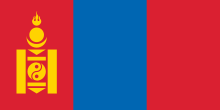 | |
 "Om" symbol in Mongolian | |
| Total population | |
|---|---|
| 0.5% of religious Mongolians follow a religion other than Buddhism, Shamanism, Islam or Christianity. | |
| Languages | |
| Mongolian | |
| Religion | |
| Hinduism |
Hinduism in Mongolia is a minority religion; it has few followers and only began to appear in Mongolia in the late twentieth century.[1] According to the 2010 and 2011 Mongolian census, the majority of people that identify as religious follow Buddhism (86%), Shamanism (4.7), Islam (4.9%) or Christianity (3.5). Only 0.5% of the population follow other religions.[1]
During the twentieth century, the socialist Mongolian People's republic restricted religious practices and enforced atheism across the country.[2] The fall of the communist regime in the late 1990s signalled the beginning of an era of religious pluralism and experimentation.[2] Mongolians began practising Hinduism and other world religions and spiritualities, including Mormonism and Christianity.[3]
Spiritual congregations that teach Hindu philosophies including The International Society for Krishna Consciousness, The Art of Living foundation and the Ananda Marga organisation operate in Ulaanbataar.[4] Practices that gain inspiration from Hinduism such as Patanjali Yoga and spiritual vegetarianism are practised in Mongolia; according to Saskia Abraahms-Kavunenko, Mongolian Buddhists have begun to incorporate Hindu spirituality and concepts into their Buddhist customs.[3] Hindu symbols have influenced Mongolian myth, legend, culture and tradition.[5]
- ^ a b Mongolianembassy.org.au. 2020. About Mongolia – Embassy Of Mongolia In Australia. [online] Available at: <https://mongolianembassy.org.au/about-mongolia/> [Accessed 14 October 2020].
- ^ a b Even, Marie-Dominique (2012). "Ritual Efficacy or Spiritual Quest? Buddhism and Modernity in Post-Communist Mongolia". Revisiting Rituals in a Changing Tibetan World. pp. 241–271. doi:10.1163/9789004235007_011. ISBN 9789004232174.
- ^ a b Abrahms-Kavunenko, Saskia (1 January 2012). "Religious 'Revival' After Socialism? Eclecticism and Globalisation Amongst Lay Buddhists in Ulaanbaatar". Inner Asia. 14 (2): 279–297. doi:10.1163/22105018-90000005. JSTOR 24572065.
- ^ Cite error: The named reference
Abrahms-Kavunenko2011was invoked but never defined (see the help page). - ^ Laufer, Berthold (April 1931). "Inspirational Dreams in Eastern Asia". The Journal of American Folklore. 44 (172): 208–216. doi:10.2307/535842. JSTOR 535842.
© MMXXIII Rich X Search. We shall prevail. All rights reserved. Rich X Search
